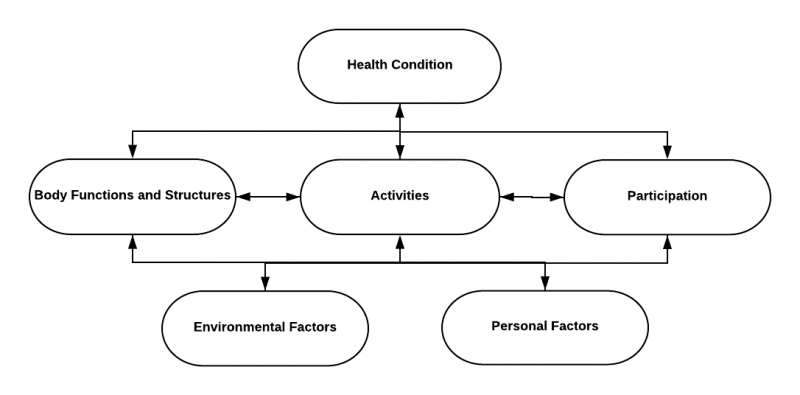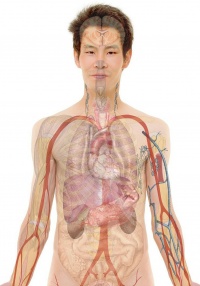International Classification of Functioning, Disability and Health (ICF): Difference between revisions
No edit summary |
No edit summary |
||
| (32 intermediate revisions by 4 users not shown) | |||
| Line 3: | Line 3: | ||
'''Top Contributors''' - {{Special:Contributors/{{FULLPAGENAME}}}} | '''Top Contributors''' - {{Special:Contributors/{{FULLPAGENAME}}}} | ||
</div | </div> | ||
== Introduction == | == Introduction == | ||
The International Classification of Functioning, Disability and Health (ICF) is a framework for describing functioning and disability in relation to a health condition. It provides a common language and framework for describing the level of function of a person within their unique environment or in other words, what a person with a specific health condition can do in a standard environment '''(their level of capacity) | [https://resources.relabhs.org/resource/a-practical-manual-for-using-the-international-classification-of-functioning-disability-and-health/ The International Classification of Functioning, Disability and Health (ICF)] is a framework for describing functioning and disability in relation to a health condition. It provides a common language and framework for describing the level of function of a person within their unique environment or in other words, what a person with a specific health condition can do in a standard environment '''(their level of capacity)''', and also what they actually do in their usual environment '''(their level of performance)''', as opposed to classifying the person by their having a specific condition or as a 'Yes/No' answer regarding disability.<ref name=":0">Sykes C. Health classifications 1 - An introduction to the ICF. WCPT Keynotes. World Confederation for Physical Therapy. 2006. </ref><ref name=":1" /> World Physiotherapy adopted a motion supporting the implementation of the ICF in physiotherapy in 2003.<ref>Escorpizo R, Stucki G, Cieza A, Davis K, Stumbo T, Riddle DL. Creating an interface between the International Classification of Functioning, Disability and Health and physical therapist practice. Phys Ther. 2010;90:1053-63.</ref> | ||
The ICF is a framework to approach patient care that shifts the conceptual emphasis away from negative connotations such as disability and places focus on function and the positive abilities of the individual at the patient level rather than the systems level. The below | The ICF is a framework to approach patient care that shifts the conceptual emphasis away from negative connotations such as disability and places focus on function and the positive abilities of the individual at the patient level rather than the systems level. The video below (3.47 minutes) gives a good introduction to the ICF. {{#ev:youtube|uoEIc4wBaIo|250}} <div class="row"><div class="col-md-6 col-md-offset-3"><div class="text-right"><ref>Pranay Jindal. Video 1 NA: What is the International Classification of Functioning, Disability and Health (ICF)?. Available from: https://youtu.be/uoEIc4wBaIo[last accessed 30/06/21]</ref></div></div></div> | ||
== Components of the ICF == | == Components of the ICF == | ||
The ICF focuses on three components: | The ICF focuses on three components, which underscores the importance of the interplay and influence of both internal and external factors to each individual’s health status.: | ||
* '''Body Functions and Structures''' | * '''Body Functions and Structures''' | ||
* '''Activities and Participation''' (at individual and societal levels) | * '''Activities and Participation''' (at individual and societal levels) | ||
* '''Personal and Environmental Factors''' (at a contextual level).<ref name=":0" /> | * '''Personal and Environmental Factors''' (at a contextual level).<ref name=":0" /> | ||
<br> | |||
[[Image:ICF Model Generic (correct version).png|thumb|800x800px|The ICF Model|alt=|center]] | |||
=== Body Functions and Structures === | === Body Functions and Structures === | ||
[[Image:Body with anatomy overlay.jpg|right|border|200px]] | |||
Definitions:<ref name=":1">[https://www.wcpt.org/sites/wcpt.org/files/files/GH-ICF_overview_FINAL_for_WHO.pdf The ICF: An Overview. Available at: https://www.wcpt.org/sites/wcpt.org/files/files/GH-ICF_overview_FINAL_for_WHO.pdf]</ref> | Definitions:<ref name=":1">[https://www.wcpt.org/sites/wcpt.org/files/files/GH-ICF_overview_FINAL_for_WHO.pdf The ICF: An Overview. Available at: https://www.wcpt.org/sites/wcpt.org/files/files/GH-ICF_overview_FINAL_for_WHO.pdf]</ref> | ||
* '''Body Functions:''' The physiological functions of body systems (including psychological functions) | * '''Body Functions:''' The physiological functions of body systems (including psychological functions) | ||
* '''Body Structures:''' Anatomical parts of the body such as organs, limbs and their components | * '''Body Structures:''' Anatomical parts of the body such as organs, limbs and their components | ||
| Line 30: | Line 30: | ||
* ''s810 Structures of areas of skin'' | * ''s810 Structures of areas of skin'' | ||
Note that codes relating to body functions start with '''<nowiki/>'b'<nowiki/>''' while codes relating to body structures start with '''<nowiki/>'s.'''' | <br>Note that codes relating to body functions start with '''<nowiki/>'b'<nowiki/>''' while codes relating to body structures start with '''<nowiki/>'s.'''' | ||
=== Activities and Participation === | === Activities and Participation === | ||
Definitions:<ref name=":1" /> | [[Image:Walking dog.jpg|right|border|300px]]Definitions:<ref name=":1" /> | ||
* '''Activity:''' The execution of a task or action by an individual | *'''Activity:''' The execution of a task or action by an individual | ||
* '''Activity Limitations:''' Difficulties an individual may have in executing activities | *'''Activity Limitations:''' Difficulties an individual may have in executing activities | ||
* '''Participation:''' Involvement in a life situation | *'''Participation:''' Involvement in a life situation | ||
* '''Participation Restrictions:''' Problems an individual may experience in involvement in life situations | *'''Participation Restrictions:''' Problems an individual may experience in involvement in life situations | ||
<br>Examples: | <br>Examples: | ||
* ''d230 Carrying out daily routine'' | * ''d230 Carrying out daily routine'' | ||
| Line 52: | Line 49: | ||
=== Environmental Factors === | === Environmental Factors === | ||
Definition:<ref name=":1" /> | [[Image:Busy environment.jpg|right|border|300px]]Definition:<ref name=":1" /> | ||
The physical, social and attitudinal environment in which people live and conduct their lives. These are either barriers to or facilitators of the person's functioning. | The physical, social and attitudinal environment in which people live and conduct their lives. These are either barriers to or facilitators of the person's functioning. | ||
Examples: | Examples: | ||
| Line 167: | Line 161: | ||
=== Performance versus Capacity === | === Performance versus Capacity === | ||
Definitions; | Definitions; | ||
* '''Capacity:''' | * '''Capacity:''' | ||
* '''Performance:''' | ** What a person can do in a standardised environment e.g. during clinical assessment.<ref name=":1" /> It indicates the extent of activity limitation as a direct manifestation of a person's health status, without any assistance (assistance of another person, equipment or environmental modification).<ref name=":7" /> | ||
* '''Performance:''' | |||
** What a person actually does in his/her usual environment e.g. at home.<ref name=":1" /> It indicates the extent of participation restriction or the "lived experience" by describing all physical, social and attitudinal environmental factors.<ref name=":7" /> It measures the difficulty a person experiences in doing things, assuming that they want to do them.<ref name=":7" /> | |||
<br>The gap between these two constructs reflects the impact that different environments can have on activities and participation.<ref name=":1" /> This gap can then guide intervention (e.g. on environmental factors) to help improve a patient's performance.<ref name=":1" /> | |||
The gap between these two constructs reflects the impact that different environments can have on activities and participation.<ref name=":1" /> This gap can then guide intervention (e.g. on environmental factors) to help improve a patient's performance.<ref name=":1" /> | |||
== ICF Core Sets == | == ICF Core Sets == | ||
The [http://www.icf-research-branch.org/download/viewcategory/5.html ICF Core Sets] were developed as a practical tool to facilitate the systematic and comprehensive description of functioning in clinical practice.<ref>Kesselring J, Coenen M, Cieza A, Thompson A, Kostanjsek N, Stucki G. Developing the ICF Core Sets for multiple sclerosis to specify functioning. Mult Scler. 2008;14:252-4.</ref><ref>Rauch A, Cieza A, Stucki G. How to apply the International Classification of Functioning, Disability and Health (ICF) for rehabilitation management in clinical practice. Eur J Phys Rehabil. 2008;44(3):329-42.</ref> They are compiled in order to provide health care professionals with a better understanding of the needs of their patient populations.<ref name=":3">Morgan KA, Engsberg JR, Gray DB. Important wheelchair skills for new manual wheelchair users: health care professional and wheelchair user perspectives. Disabil Rehabil Assist Technol. 2017 Jan;12(1):28-38. | The [http://www.icf-research-branch.org/download/viewcategory/5.html ICF Core Sets] were developed as a practical tool to facilitate the systematic and comprehensive description of functioning in clinical practice.<ref>Kesselring J, Coenen M, Cieza A, Thompson A, Kostanjsek N, Stucki G. Developing the ICF Core Sets for multiple sclerosis to specify functioning. Mult Scler. 2008;14:252-4.</ref><ref>Rauch A, Cieza A, Stucki G. How to apply the International Classification of Functioning, Disability and Health (ICF) for rehabilitation management in clinical practice. Eur J Phys Rehabil. 2008;44(3):329-42.</ref> They are compiled in order to provide health care professionals with a better understanding of the needs of their patient populations.<ref name=":3">Morgan KA, Engsberg JR, Gray DB. Important wheelchair skills for new manual wheelchair users: health care professional and wheelchair user perspectives. Disabil Rehabil Assist Technol. 2017 Jan;12(1):28-38. | ||
</ref> Core sets for twelve chronic diseases were initially developed because of their prevalence and the significant impact on function they can cause.<ref name=":2">Sykes C. Health classifications 2 - Using the ICF in clinical practice. WCPT Keynotes. World Confederation for Physical Therapy. 2007.</ref> | </ref> Core sets for twelve chronic diseases were initially developed because of their prevalence and the significant impact on function they can cause.<ref name=":2">Sykes C. Health classifications 2 - Using the ICF in clinical practice. WCPT Keynotes. World Confederation for Physical Therapy. 2007.</ref> With additional Core Sets subsequently developed for various other conditions and populations. All available ICF Core Sets can be viewed [https://www.icf-research-branch.org/download/category/4-icf-core-sets here]. | ||
{| width="100%" border="1" cellpadding="1" cellspacing="1" | |||
*[[Ankylosing Spondylitis (Axial Spondyloarthritis)]] | |- | ||
*[[ | ! scope="col" | Chronic Diseases | ||
*[[ | ! scope="col" | Additional Core Sets | ||
|- | |||
| | |||
* [https://www.icf-research-branch.org/icf-core-sets-projects2/cancer/icf-core-set-for-breast-cancer Breast Cancer] | |||
* | |||
*[https://www.icf-research-branch.org/icf-core-sets-projects2/cardiovascular-and-respiratory-conditions/icf-core-set-for-chronic-ischaemic-heart-disease Chronic Ischaemic Heart Disease] | |||
*[https://www.icf-research-branch.org/icf-core-sets-projects2/cardiovascular-and-respiratory-conditions/icf-core-set-for-obstructivepulmonary-diseases Chronic Obstructive Pulmonary Diseases] | |||
*[https://www.icf-research-branch.org/icf-core-sets-projects2/musculoskeletal-conditions/icf-core-set-for-chronic-widespread-pain Chronic Widespread Pain] | |||
*[https://www.icf-research-branch.org/icf-core-sets-projects2/mental-health/icf-core-set-for-depression Depression] | |||
*[https://www.icf-research-branch.org/icf-core-sets-projects2/cardiovascular-and-respiratory-conditions/icf-core-set-for-diabetes-mellitus Diabetes Mellitus] | |||
*[https://www.icf-research-branch.org/icf-core-sets-projects2/musculoskeletal-conditions/icf-core-set-for-low-back-pain Low Back Pain] | |||
*[https://www.icf-research-branch.org/icf-core-sets-projects2/cardiovascular-and-respiratory-conditions/icf-core-set-for-obesity Obesity] | |||
*[https://www.icf-research-branch.org/icf-core-sets-projects2/musculoskeletal-conditions/icf-core-set-for-osteoarthritis Osteoarthritis] | |||
*[https://www.icf-research-branch.org/icf-core-sets-projects2/musculoskeletal-conditions/icf-core-set-for-osteoporosis Osteoporosis] | |||
*[https://www.icf-research-branch.org/icf-core-sets-projects2/musculoskeletal-conditions/icf-core-set-for-rheumatoid-arthritis Rheumatoid Arthritis] | |||
*[https://www.icf-research-branch.org/icf-core-sets-projects2/cardiovascular-and-respiratory-conditions/icf-core-set-for-stroke Stroke] | |||
| | |||
*[https://www.icf-research-branch.org/icf-core-sets-projects2/other-health-conditions/icf-core-set-for-persons-following-an-amputation Amputation] | |||
*[https://www.icf-research-branch.org/icf-core-sets-projects2/musculoskeletal-conditions/development-of-the-icf-core-sets-for-ankylosing-spondylitis Ankylosing Spondylitis (Axial Spondyloarthritis)] | |||
*[https://www.icf-research-branch.org/icf-core-sets-projects2/other-health-conditions/icf-core-set-for-adhd Attention Deficit Hyperactivity Disorder (ADHD)] | |||
*[https://www.icf-research-branch.org/icf-core-sets-projects2/other-health-conditions/icf-core-set-for-autism-spectrum Autism Spectrum Disorder] | |||
*[https://www.icf-research-branch.org/icf-core-sets-projects2/mental-health/development-of-the-icf-core-sets-for-bipolar-disorders Bipolar Disorder] | |||
*[https://www.icf-research-branch.org/icf-core-sets-projects2/neurological-conditions/686-icf-core-set-for-adults-with-cerebral-palsy Cerebral Palsy] | |||
*[https://www.icf-research-branch.org/icf-core-sets-projects2/other-health-conditions/development-of-icf-core-sets-for-hand-conditions Hand Conditions] | |||
*[https://www.icf-research-branch.org/icf-core-sets-projects2/other-health-conditions/icf-core-set-for-hearing-loss Hearing Loss] | |||
*[https://www.icf-research-branch.org/icf-core-sets-projects2/other-health-conditions/icf-core-sets-for-inflammatory-bowel-diseases Inflammatory Bowel Disease] | |||
*[https://www.icf-research-branch.org/icf-core-sets-projects2/neurological-conditions/development-of-icf-core-sets-for-multiple-sclerosis-ms Multiple Sclerosis] | |||
*[https://www.icf-research-branch.org/images/ICF%20Core%20Sets%20Download/icf_rehabilitation_set.pdf Rehabilitation] | |||
*[https://www.icf-research-branch.org/icf-core-sets-projects2/mental-health/icf-core-set-for-schizophrenia Schizophrenia] | |||
*[https://www.icf-research-branch.org/icf-core-sets-projects2/other-health-conditions/development-of-icf-core-sets-for-sleep Sleep] | |||
*[[Spinal Cord Injury]] | *[[Spinal Cord Injury]] | ||
*[ | *[https://www.icf-research-branch.org/icf-core-sets-projects2/neurological-conditions/development-of-icf-core-sets-for-traumatic-brain-injury-tbi Traumatic Brain Injury] | ||
* | *[https://www.icf-research-branch.org/icf-core-sets-projects2/other-health-conditions/icf-core-set-for-vertigo Vertigo] | ||
*[https://www.icf-research-branch.org/icf-core-sets-projects2/diverse-situations/icf-core-sets-for-vocational-rehabilitation Vocational Rehabilitation] | |||
* | |||
* | |||
|- | |||
|} | |||
=== Families and the ICF === | === Families and the ICF === | ||
{{#ev:youtube|yyt0rxxYGH4|250}} <div class="row"><div class="col-md-6 col-md-offset-3"><div class="text-right"><ref>Jennifer Johannesen. Families and the ICF. Available from: https://youtu.be/yyt0rxxYGH4[last accessed 30/06/21]</ref></div></div></div> | {{#ev:youtube|yyt0rxxYGH4|250}} <div class="row"><div class="col-md-6 col-md-offset-3"><div class="text-right"><ref>Jennifer Johannesen. Families and the ICF. Available from: https://youtu.be/yyt0rxxYGH4[last accessed 30/06/21]</ref></div></div></div> | ||
| Line 210: | Line 221: | ||
== Resources == | == Resources == | ||
=== WHO Resources === | |||
#[https://resources.relabhs.org/resource/international-classification-of-functioning-disability-and-health-icf-beginners-guide/ Towards a Common Language for Functioning, Disability and Health: A guide for beginners] | |||
#[https://resources.relabhs.org/resource/a-practical-manual-for-using-the-international-classification-of-functioning-disability-and-health/ A Practical Manual for using the International Classification of Functioning, Disability and Health] | |||
#[https://www.icf-elearning.com/ ICF e-Learning Tool] | |||
#*The introductory module of the ICF e-Learning Tool is online and is available in several languages. The introductory module is ideal for anyone interested in learning about the ICF. | |||
#[http://apps.who.int/classifications/icfbrowser/ ICF Browser] | |||
#*Using this online browser you can see the structure of the classification, look up the codes and definitions, create your own shortlists of ICF codes and view the classification in more than one language. | |||
#[https://www.icf-research-branch.org/icf-core-sets ICF Core Sets] | |||
#*Access to all current ICF Core Sets | |||
#[https://cdn.who.int/media/docs/default-source/classification/icf/icfchecklist.pdf?sfvrsn=b7ff99e9_4&download=true ICF Checklist] | |||
#*The user–friendly display of the most relevant ICF categories for clinical purposes. The checklist allows the user to identify and qualify the individuals functioning profile in a simple and time-efficient manner. | |||
#[https://www.icf-research-branch.org/icf-case-studies ICF Case Studies] | |||
#*To illustrate the use of the International Classification of Functioning, Disability and Health (ICF) in rehabilitation practice, Swiss Paraplegic Research initiated the project "Case studies" in 2007. Using ICF tools within the framework of the "Rehab-Cycle", it follows the rehabilitation journey of a number of individuals with a spinal cord injury. | |||
=== Videos === | === Videos === | ||
<div class="row"> | <div class="row"> | ||
<div class="col-md- | <div class="col-md-3"> {{#ev:youtube|O2pRqr-THMs|150}} <div class="text-right"><ref>Pranay Jindal. Video 2 NA: What is “Body Structure and Function”?. Available from: https://youtu.be/O2pRqr-THMs[last accessed 30/06/21]</ref></div></div> | ||
<div class="col-md- | <div class="col-md-3">{{#ev:youtube|mwYxs567Cg0|150}} <div class="text-right"><ref>Pranay Jindal. Video 3 NA: What are “Activity and Participation”?. Available from: https://youtu.be/mwYxs567Cg0[last accessed 30/06/21]</ref></div></div> | ||
<div class="col-md-3">{{#ev:youtube|-j0495iwCX0|150}} <div class="text-right"><ref>Pranay Jindal. Video 4 NA: What are “contextual factors”?. Available from: https://youtu.be/-j0495iwCX0[last accessed 30/06/21]</ref></div></div> | |||
<div class="col-md-3">{{#ev:youtube|Vj7cF63egGU|150}} <div class="text-right"><ref>Pranay Jindal. Video 5 NA: How do different parts of the ICF work together?. Available from: https://youtu.be/Vj7cF63egGU[last accessed 30/06/21]</ref></div></div> | |||
</div> | </div> | ||
== References == | == References == | ||
| Line 240: | Line 251: | ||
[[Category:Rehabilitation]] | [[Category:Rehabilitation]] | ||
[[Category:Understanding Rehabilitation Content Development Project]] | [[Category:Understanding Rehabilitation Content Development Project]] | ||
[[Category:ReLAB-HS Course Page]] | |||
Latest revision as of 12:04, 15 November 2022
Original Editors - Laura Ritchie
Top Contributors - Laura Ritchie, Naomi O'Reilly, Kim Jackson, Admin, Shaimaa Eldib, WikiSysop, Lucinda hampton, Merinda Rodseth, Oyemi Sillo, Tarina van der Stockt, Simisola Ajeyalemi, Lauren Kwant, Nicole Hills, Ewa Jaraczewska and Rachael Lowe
Introduction[edit | edit source]
The International Classification of Functioning, Disability and Health (ICF) is a framework for describing functioning and disability in relation to a health condition. It provides a common language and framework for describing the level of function of a person within their unique environment or in other words, what a person with a specific health condition can do in a standard environment (their level of capacity), and also what they actually do in their usual environment (their level of performance), as opposed to classifying the person by their having a specific condition or as a 'Yes/No' answer regarding disability.[1][2] World Physiotherapy adopted a motion supporting the implementation of the ICF in physiotherapy in 2003.[3]
The ICF is a framework to approach patient care that shifts the conceptual emphasis away from negative connotations such as disability and places focus on function and the positive abilities of the individual at the patient level rather than the systems level. The video below (3.47 minutes) gives a good introduction to the ICF.
Components of the ICF[edit | edit source]
The ICF focuses on three components, which underscores the importance of the interplay and influence of both internal and external factors to each individual’s health status.:
- Body Functions and Structures
- Activities and Participation (at individual and societal levels)
- Personal and Environmental Factors (at a contextual level).[1]
Body Functions and Structures[edit | edit source]
Definitions:[2]
- Body Functions: The physiological functions of body systems (including psychological functions)
- Body Structures: Anatomical parts of the body such as organs, limbs and their components
- Impairments: Problems in body function and structure such as significant deviation or loss
Examples:
- b28010 Pain in head and neck
- s720 Structure of shoulder region
- s810 Structures of areas of skin
Note that codes relating to body functions start with 'b' while codes relating to body structures start with 's.'
Activities and Participation[edit | edit source]
Definitions:[2]
- Activity: The execution of a task or action by an individual
- Activity Limitations: Difficulties an individual may have in executing activities
- Participation: Involvement in a life situation
- Participation Restrictions: Problems an individual may experience in involvement in life situations
Examples:
- d230 Carrying out daily routine
- d420 Transferring oneself
- d475 Driving
- d530 Toileting
- d910 Community life
- d920 Recreation and leisure
Note that codes relating to both activities and participation start with the letter d.
Environmental Factors[edit | edit source]
Definition:[2]
The physical, social and attitudinal environment in which people live and conduct their lives. These are either barriers to or facilitators of the person's functioning.
Examples:
- e115 Products and technology for personal use in daily living
- e155 Design, construction and building products and technology of buildings for private use
- e210 Physical geography
- e355 Health professionals
Note that codes relating to environmental factors start with the letter e.
Personal Factors[edit | edit source]
Personal Factors should also be considered in this model but are not classified within the actual ICF framework.[1]
Contents of ICF Components[edit | edit source]
Each component is divided into a hierarchy with an additional digit added to the classification code for each subsequent layer in the hierarchy. The hierarchy is as follows;[1]
- Component e.g. Activities and participation
- Chapter e.g. Mobility (Chapter 4)
- Block e.g. Walking and Moving (d450-d469)
- Two-level Category e.g. Moving around in different locations (d460)
- Three-level Category e.g. Moving around within the home (d4600)
Measurement[edit | edit source]
A generic qualifier scale can be used to record the extent of the problem for each identified impairment, activity limitation and participation restriction. Environmental factors can also be qualified as either barriers or facilitators.[5]
| Qualifier for Impairments of Body Functions & Structures | Qualifier for Impairments of Activities & Participation | |
|---|---|---|
| 0 | No impairment | No difficulty |
| 1 | Mild impairment:
Present <25% of time, with tolerable intensity, occurring rarely over last 30 days |
Mild difficulty
Present <25% of time, with tolerable intensity, occurring rarely over last 30 days |
| 2 | Moderate Impairment
Present <50% of time, with intensity that interferes with day to day lift, occurring occasionally over last 30 days |
Moderate Difficulty
Present <50% of time, with intensity that interferes with day to day lift, occurring occasionally over last 30 days |
| 3 | Severe Impairment
Present >50% of time, with intensity that's partially disrupting day to day lift, occurring frequently over last 30 days |
Severe Difficulty
Present >50% of time, with intensity that's partially disrupting day to day lift, occurring frequently over last 30 days) |
| 4 | Complete Impairment
Present >95% of time, with intensity that's totally disrupting day to day life, occurring daily over last 30 days |
Complete Difficulty
Present >95% of time, with intensity that's totally disrupting day to day life, occurring daily over last 30 days |
| 8 | Not Specified
Insufficient information |
Not Specified |
| 9 | Not Applicable | Not Applicable |
| Qualifier for Environmental Barriers | Qualifier for Environmental Facilitators | ||
|---|---|---|---|
| (.0) | No barrier | (+0) | No facilitator |
| (.1) | Mild barrier | (+1) | Mild facilitator |
| (.2) | Moderate barrier | (+2) | Moderate facilitator |
| (.3) | Severe barrier | (+3) | Substantial facilitator |
| (.4) | Complete barrier | (+4) | Complete facilitator |
| (.8) | Barrier, not specified | (+8) | Facilitator, not specified |
| (.9) | Not applicable | (+9) | Not applicable |
Explaining Walking Activity by using ICF model
Performance versus Capacity[edit | edit source]
Definitions;
- Capacity:
- Performance:
- What a person actually does in his/her usual environment e.g. at home.[2] It indicates the extent of participation restriction or the "lived experience" by describing all physical, social and attitudinal environmental factors.[5] It measures the difficulty a person experiences in doing things, assuming that they want to do them.[5]
The gap between these two constructs reflects the impact that different environments can have on activities and participation.[2] This gap can then guide intervention (e.g. on environmental factors) to help improve a patient's performance.[2]
ICF Core Sets[edit | edit source]
The ICF Core Sets were developed as a practical tool to facilitate the systematic and comprehensive description of functioning in clinical practice.[6][7] They are compiled in order to provide health care professionals with a better understanding of the needs of their patient populations.[8] Core sets for twelve chronic diseases were initially developed because of their prevalence and the significant impact on function they can cause.[9] With additional Core Sets subsequently developed for various other conditions and populations. All available ICF Core Sets can be viewed here.
Families and the ICF[edit | edit source]
ICF in Relation to Wheelchair Users[edit | edit source]
Please see this page for information on use of the ICF in relation to users of wheelchairs.
Resources[edit | edit source]
WHO Resources[edit | edit source]
- Towards a Common Language for Functioning, Disability and Health: A guide for beginners
- A Practical Manual for using the International Classification of Functioning, Disability and Health
- ICF e-Learning Tool
- The introductory module of the ICF e-Learning Tool is online and is available in several languages. The introductory module is ideal for anyone interested in learning about the ICF.
- ICF Browser
- Using this online browser you can see the structure of the classification, look up the codes and definitions, create your own shortlists of ICF codes and view the classification in more than one language.
- ICF Core Sets
- Access to all current ICF Core Sets
- ICF Checklist
- The user–friendly display of the most relevant ICF categories for clinical purposes. The checklist allows the user to identify and qualify the individuals functioning profile in a simple and time-efficient manner.
- ICF Case Studies
- To illustrate the use of the International Classification of Functioning, Disability and Health (ICF) in rehabilitation practice, Swiss Paraplegic Research initiated the project "Case studies" in 2007. Using ICF tools within the framework of the "Rehab-Cycle", it follows the rehabilitation journey of a number of individuals with a spinal cord injury.
Videos[edit | edit source]
References[edit | edit source]
- ↑ 1.0 1.1 1.2 1.3 Sykes C. Health classifications 1 - An introduction to the ICF. WCPT Keynotes. World Confederation for Physical Therapy. 2006.
- ↑ 2.0 2.1 2.2 2.3 2.4 2.5 2.6 2.7 The ICF: An Overview. Available at: https://www.wcpt.org/sites/wcpt.org/files/files/GH-ICF_overview_FINAL_for_WHO.pdf
- ↑ Escorpizo R, Stucki G, Cieza A, Davis K, Stumbo T, Riddle DL. Creating an interface between the International Classification of Functioning, Disability and Health and physical therapist practice. Phys Ther. 2010;90:1053-63.
- ↑ Pranay Jindal. Video 1 NA: What is the International Classification of Functioning, Disability and Health (ICF)?. Available from: https://youtu.be/uoEIc4wBaIo[last accessed 30/06/21]
- ↑ 5.0 5.1 5.2 5.3 World Health Organization. ICF Checklist Version 2.1a, Clinician Form. 2003. Available at: http://www.who.int/classifications/icf/training/icfchecklist.pdf
- ↑ Kesselring J, Coenen M, Cieza A, Thompson A, Kostanjsek N, Stucki G. Developing the ICF Core Sets for multiple sclerosis to specify functioning. Mult Scler. 2008;14:252-4.
- ↑ Rauch A, Cieza A, Stucki G. How to apply the International Classification of Functioning, Disability and Health (ICF) for rehabilitation management in clinical practice. Eur J Phys Rehabil. 2008;44(3):329-42.
- ↑ Morgan KA, Engsberg JR, Gray DB. Important wheelchair skills for new manual wheelchair users: health care professional and wheelchair user perspectives. Disabil Rehabil Assist Technol. 2017 Jan;12(1):28-38.
- ↑ Sykes C. Health classifications 2 - Using the ICF in clinical practice. WCPT Keynotes. World Confederation for Physical Therapy. 2007.
- ↑ Jennifer Johannesen. Families and the ICF. Available from: https://youtu.be/yyt0rxxYGH4[last accessed 30/06/21]
- ↑ Pranay Jindal. Video 2 NA: What is “Body Structure and Function”?. Available from: https://youtu.be/O2pRqr-THMs[last accessed 30/06/21]
- ↑ Pranay Jindal. Video 3 NA: What are “Activity and Participation”?. Available from: https://youtu.be/mwYxs567Cg0[last accessed 30/06/21]
- ↑ Pranay Jindal. Video 4 NA: What are “contextual factors”?. Available from: https://youtu.be/-j0495iwCX0[last accessed 30/06/21]
- ↑ Pranay Jindal. Video 5 NA: How do different parts of the ICF work together?. Available from: https://youtu.be/Vj7cF63egGU[last accessed 30/06/21]










